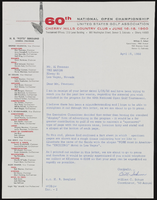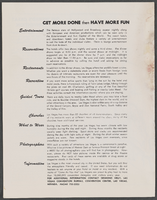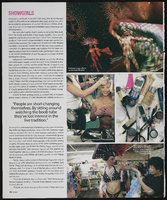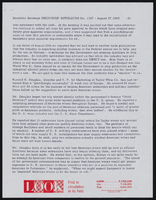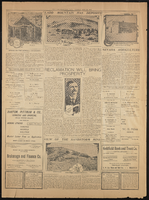Search the Special Collections and Archives Portal
Search Results

Francisco Rufino Parra interview, December 6, 2018: transcript
Date
Archival Collection
Description
Interviewed by Barbara Tabach. Born in Mexico, Francisco was a child when his father received permission to immigrate to the US with his younger children. Upon graduating from high school in California, he moved to Las Vegas where one of his sisters lived. It was 1994 and jobs were plentiful; he would find his way through several positions. Then in early 2000 he was hired to be a dishwasher, on the graveyard, at the recently opened Paris Hotel. It was a Culinary Union job; by 2002 he was a shop steward and finding better positions at Paris. He continues to work at the Paris Hotel as a fry cook. In 2008, he was a citizen and proudly voted in his first presidential election.
Text

Transcript of interview with Clark Crocker by Monica Lehman, March 3, 1978
Date
Archival Collection
Description
On March 3, 1978, Monica Lehman interviewed Clark Crocker (born 1920 in Westfield, Massachusetts) about his experiences while living in Nevada. Crocker first talks about his family and educational background before describing his experiences from going to school in both California and Massachusetts. Crocker then describes what he knows about the building of Hoover Dam and later talks about his career as a teacher and school principal. The two also discuss Crocker’s hobbies and volunteer work, including that for the fire department in Pahrump, and they later discuss Crocker’s experiences as both a frogman and navigator for the United States Navy during World War II. The interview concludes with some of Crocker’s thoughts and philosophies on how curriculum should be structured in schools.
Text
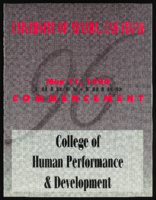
University of Nevada, Las Vegas (UNLV) College of Human Performance and Development 33rd commencement program
Date
Archival Collection
Description
Commencement program from University of Nevada, Las Vegas Commencement Programs and Graduation Lists (UA-00115).
Text

Transcript of interview with James M. Bonaventure by Claytee D. White, September 9, 2014
Date
Archival Collection
Description
Text
Milt Palmer Photographs
Identifier
Abstract
The Milt Palmer Photographs (approximately 1950-1991) contain original and reproductions of photographic prints taken by Milt Palmer, a photographer who worked for the Las Vegas Chamber of Commerce, and later under the division known as the Las Vegas News Bureau. Palmer captured celebrities and entertainers performing their Las Vegas shows, athletes in various sporting events, and various political figures. The majority of photographs in the collection are from approximately the 1950s to 1960s and some are signed by entertainers. The collection also includes digital reproductions of approximately half of the images found in the collection.
Archival Collection

